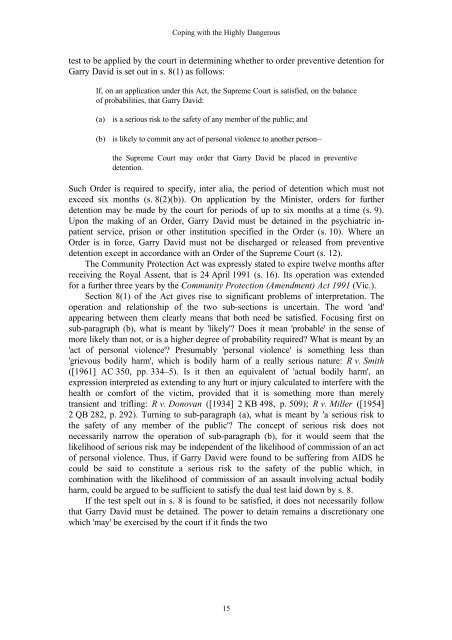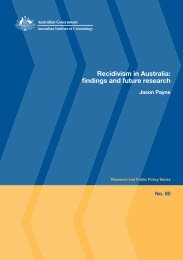Coping with the highly dangerous : issues of principle raised by ...
Coping with the highly dangerous : issues of principle raised by ...
Coping with the highly dangerous : issues of principle raised by ...
Create successful ePaper yourself
Turn your PDF publications into a flip-book with our unique Google optimized e-Paper software.
<strong>Coping</strong> <strong>with</strong> <strong>the</strong> Highly Dangerous<br />
test to be applied <strong>by</strong> <strong>the</strong> court in determining whe<strong>the</strong>r to order preventive detention for<br />
Garry David is set out in s. 8(1) as follows:<br />
If, on an application under this Act, <strong>the</strong> Supreme Court is satisfied, on <strong>the</strong> balance<br />
<strong>of</strong> probabilities, that Garry David:<br />
(a) is a serious risk to <strong>the</strong> safety <strong>of</strong> any member <strong>of</strong> <strong>the</strong> public; and<br />
(b) is likely to commit any act <strong>of</strong> personal violence to ano<strong>the</strong>r person—<br />
<strong>the</strong> Supreme Court may order that Garry David be placed in preventive<br />
detention.<br />
Such Order is required to specify, inter alia, <strong>the</strong> period <strong>of</strong> detention which must not<br />
exceed six months (s. 8(2)(b)). On application <strong>by</strong> <strong>the</strong> Minister, orders for fur<strong>the</strong>r<br />
detention may be made <strong>by</strong> <strong>the</strong> court for periods <strong>of</strong> up to six months at a time (s. 9).<br />
Upon <strong>the</strong> making <strong>of</strong> an Order, Garry David must be detained in <strong>the</strong> psychiatric inpatient<br />
service, prison or o<strong>the</strong>r institution specified in <strong>the</strong> Order (s. 10). Where an<br />
Order is in force, Garry David must not be discharged or released from preventive<br />
detention except in accordance <strong>with</strong> an Order <strong>of</strong> <strong>the</strong> Supreme Court (s. 12).<br />
The Community Protection Act was expressly stated to expire twelve months after<br />
receiving <strong>the</strong> Royal Assent, that is 24 April 1991 (s. 16). Its operation was extended<br />
for a fur<strong>the</strong>r three years <strong>by</strong> <strong>the</strong> Community Protection (Amendment) Act 1991 (Vic.).<br />
Section 8(1) <strong>of</strong> <strong>the</strong> Act gives rise to significant problems <strong>of</strong> interpretation. The<br />
operation and relationship <strong>of</strong> <strong>the</strong> two sub-sections is uncertain. The word 'and'<br />
appearing between <strong>the</strong>m clearly means that both need be satisfied. Focusing first on<br />
sub-paragraph (b), what is meant <strong>by</strong> 'likely'? Does it mean 'probable' in <strong>the</strong> sense <strong>of</strong><br />
more likely than not, or is a higher degree <strong>of</strong> probability required? What is meant <strong>by</strong> an<br />
'act <strong>of</strong> personal violence'? Presumably 'personal violence' is something less than<br />
'grievous bodily harm', which is bodily harm <strong>of</strong> a really serious nature: R v. Smith<br />
([1961] AC 350, pp. 334–5). Is it <strong>the</strong>n an equivalent <strong>of</strong> 'actual bodily harm', an<br />
expression interpreted as extending to any hurt or injury calculated to interfere <strong>with</strong> <strong>the</strong><br />
health or comfort <strong>of</strong> <strong>the</strong> victim, provided that it is something more than merely<br />
transient and trifling: R v. Donovan ([1934] 2 KB 498, p. 509); R v. Miller ([1954]<br />
2 QB 282, p. 292). Turning to sub-paragraph (a), what is meant <strong>by</strong> 'a serious risk to<br />
<strong>the</strong> safety <strong>of</strong> any member <strong>of</strong> <strong>the</strong> public'? The concept <strong>of</strong> serious risk does not<br />
necessarily narrow <strong>the</strong> operation <strong>of</strong> sub-paragraph (b), for it would seem that <strong>the</strong><br />
likelihood <strong>of</strong> serious risk may be independent <strong>of</strong> <strong>the</strong> likelihood <strong>of</strong> commission <strong>of</strong> an act<br />
<strong>of</strong> personal violence. Thus, if Garry David were found to be suffering from AIDS he<br />
could be said to constitute a serious risk to <strong>the</strong> safety <strong>of</strong> <strong>the</strong> public which, in<br />
combination <strong>with</strong> <strong>the</strong> likelihood <strong>of</strong> commission <strong>of</strong> an assault involving actual bodily<br />
harm, could be argued to be sufficient to satisfy <strong>the</strong> dual test laid down <strong>by</strong> s. 8.<br />
If <strong>the</strong> test spelt out in s. 8 is found to be satisfied, it does not necessarily follow<br />
that Garry David must be detained. The power to detain remains a discretionary one<br />
which 'may' be exercised <strong>by</strong> <strong>the</strong> court if it finds <strong>the</strong> two<br />
15















